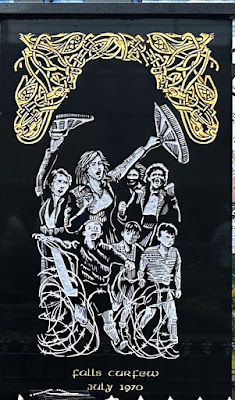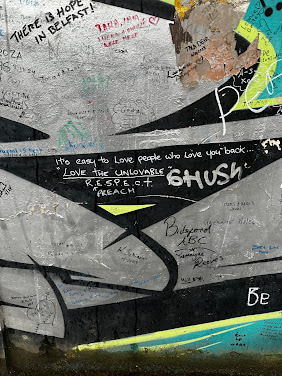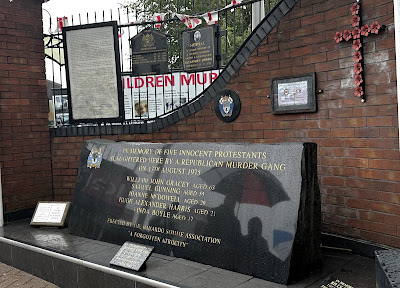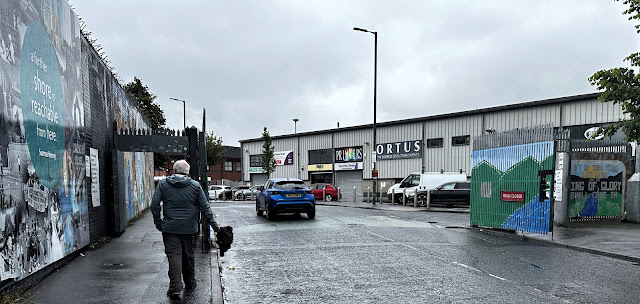July 10, 2024
Friends who visited Northern Ireland a year or two ago recommended a tour they took in Belfast that was split into two parts. Half was led by an Irish Nationalist on the Catholic side of Belfast, and the other half was led by a British Loyalist on the Protestant side of the city. There are several of these tours offered by different companies, and Bob reserved a spot in one that looked good.
We started on the Catholic/Nationalist side near this sign commemorating the 1969 riots that mark the beginning of the 30-year conflict known as "The Troubles." The conflict began with the three-day Battle of the Bogside in Derry, and it wasn't long before riots and violence broke out in Belfast. The British Army intervened on August 14, and official Catholic and Protestant districts were subsequently outlined.
Our guide on the Catholic side had been part of the IRA and had spent many years in prison for his role in the fighting. It was crazy because he looked at sounded like a sweet grandpa. Note that he is wearing an Irish-green version of the keffiyeh, which has become a symbol of Palestinian resistance. We learned that the Irish Nationalists identify with the Palestinians as a repressed people and are very anti-Israel.
We walked down one of the main streets, passing this series of large murals that links the Irish and Palestinian struggles.
A script runs through the paintings that reads, "If I must die, you must live to tell my story, to sell my things, to buy a piece of cloth and some strings (make it white with a long tail) so that a child somewhere, while looking heaven in the eye . . .
. . . awaiting his dad who was left in a blaze--and bid no one farewell, not even to his flesh, not even to himself--sees the kite, my kite you made, flying up above, and thinks for a moment an angel is there bringing back love. If I must die, let it bring hope, let it be a tale."
This poem was written by Palestinian Refaat Alareer before he was killed in an airstrike by the Israeli military.
The Nationalist-Loyalist conflict felt a little more present and intense in Belfast compared to what we had experienced in Derry.
We stopped in a city park ringed by more Irish Nationalist murals and photos.
This section memorializes an event that occurred almost 50 years before The Troubles began--the Falls Road Massacre of 1920, during which four unarmed civilians were shot on Falls Road in Belfast by a British Army patrol. The four victims were part of the 500 mostly Catholic citizens killed in Belfast between 1920-1922.
Another mural remembers the Battle of the Falls, aka Falls Curfew, of 1970, which began as a search for weapons in a nationalist neighborhood and got violent when local teens threw stones and gas bombs, and the soldiers responded with gas and sealed off the area of 3,000 homes, imposing a 36-hour curfew while British troops went house-to-house looking for weapons and leaving destruction in their wake. The incident increased support for the Catholics/nationalists and for the IRA.
There were more billboards that related to current politics.
Inside the iron gate, a pathway leads to this large plaque "dedicated to those brave and gallant" members of the "Irish Republican Army who made the supreme sacrifice in the quest for Irish Freedom."
Twenty names are listed in the center panel with the dates of their deaths.
Powerful images flank the names on either side.
Another plaque lists twelve names of those who died on hunger strikes between 1974 and 1978 while being held in prison. Perhaps the most famous of these is the second one on the list, Bobby Sands, who was the IRA leader in the prison. He is famous for this quote: "No part is too great or too small, no one is too old or too young to do something. Our revenge will be the laughter of our children. They won't break me because the desire for freedom, and the freedom of the Irish people, is in my heart."
The pictures of the twelve hunger-strikers are mounted on a giant "H." Maybe the H is for Hunger? I don't know.
Honestly, I thought this was a portrait of a woman, but Bobby Sands is a man.
Floral wreaths of green, orange, and white--the colors of the flag of the Republic of Ireland--are spread around the garden.
At the end of this first part of the tour, our guide took us to what is ironically known as the "Peace Wall." Really, it is a wall attempting to "keep the peace" by keeping the Loyalists and Nationalists apart. This was built in 1969 when conflict broke out. In places is 25 feet high.
The Peace Wall even has its own versions of Checkpoint Charlie, the infamous crossing between East and West Berlin.
Our Nationalist/Catholic guide escorted us through the gates and left us in the hands of the Unionist/Protestant guide. The two were civil to each other, but when Bob asked the new guide if they ever got together to talk about their work, the guide replied "Never." Very sad.
On the Union/Protestant side, the Peace Wall looked a little more ominous and had sections covered with graffiti.
As on the Nationalist/Catholic side, there were many indications of strong patriotism.
In particular, we noticed that the British flag was proudly displayed on almost every street.
As on the other side of the wall, there are many memorials for those killed in the conflict. For example, this clock refers to the day an IRA bomb exploded in a fish shop on Shankill Road, killing 10 people and wounding more than 50. Only 9 people are listed on the plaque because one of the dead was one of the bombers.
There are memorials to individuals, small plots decorated with silk flowers and mementos.
The park has a lamppost that memorializes victims of the aforementioned Shankill Road fish shop bombing, and next to it is a granite monolith inscribed with these words: "This lamp has been erected and dedicated to the memory of those innocent victims of the Shankill Bombing on Saturday 23 October 1993 and to all innocent victims of terrorism from the Shankill Community." Then to really hammer it home, a verse from the Gospel of Luke is included: "To give light to them that sit in darkness and in the shadow of death, to guide our feet into the way of peace. (Luke 1:79)"
It turns out the the park is actually a war memorial, and hence the profusion of red poppies, symbol of World War I. A carved granite slab that looks like a tombstone bears these engraved words: "This memorial and park is dedicated to the memory of those members of HM forces who served and died. 1914-1918, 1939-1945, Subsequent Conflicts."
Our guide pointed out that HIS SIDE was much better at honoring their World War soldiers than the OTHER SIDE, who only wanted to air their grievances against Great Britain. That did seem to be true. This large sign on the side of a building honors World War I soldiers from the Northern Ireland Ulster province.
The heart of The Troubles in Belfast was Shankill Road. This area of Belfast is where the paramilitary Ulster Volunteer Force (UVF) and Ulster Defence Association (UDA) originated. It was on Shankill Road that the two of the three men below, members of the UVF, were gunned down by the Irish National Liberation Army in 1994. 1994!! The third man, the one in the center, was also a member of the UVF and was shot by a member of the Irish Republican Army in 1987.
Their pictures are also on another memorial wall.
This sign reflects on the ISIS bombings in London in 2005 and compares it to an attack of the IRA in Belfast in 1973, stating that there is no difference between the two groups.
By the way, Sinn-Fein is an Irish Republican political part that is active in both the Republic of Ireland and Northern Ireland. During The Troubles it was associated with the IRA.

It has become increasingly powerful in both countries, and for the first time, the current First Minister of Northern Ireland is a member of Sinn Fein (and a woman too boot)! I believe this poster we saw on our walk is that woman, Michelle O'Neill.

But I digress. Although the two events on the poster below were 53 and 36 years ago, they are presented here as if they were much more recent, and it is obvious that reconciliation is not happening soon.
More of the same . . .
. . . and more . . .
. . . and more!
And no surprise, Northern Ireland Loyalists support Israel in their war with Palestine.
Back on the Irish Republican/Catholic side, we appreciated the murals painted on the wall that seemed to be reaching out for peace.

Some familiar faces here: Sojourner Truth, Frederick Douglass, Martin Luth King, Muhammad Ali, and yes, Bob Marley (bottom right), among others.
And here's Nelson Mandela with the quote: "In my country we go to prison first and then become President."




































































An incredible tour. I loved our Irish National guide who spent years in prison (I think about 17), knew Bobby Sands, and was part of the hunger strike. He seemed so humble, friendly and down to earth. He recalled spreading his own feces on the prison walls during the hunger strike. He seemed incredibly decent and kind. In contrast, the Loyalist guide seemed harsh, unyielding, and a bully. I was really put-off by him. Growing up, remembering the news from Northern Ireland, Sin Feinn was a horrible group and the Irish Nationals were terrorists. After visiting, my sympathy leaned more toward the Irish Nationals. This was an incredible learning experience and this tour was one of the best, if not the best, we have had in all of our travels.
ReplyDelete